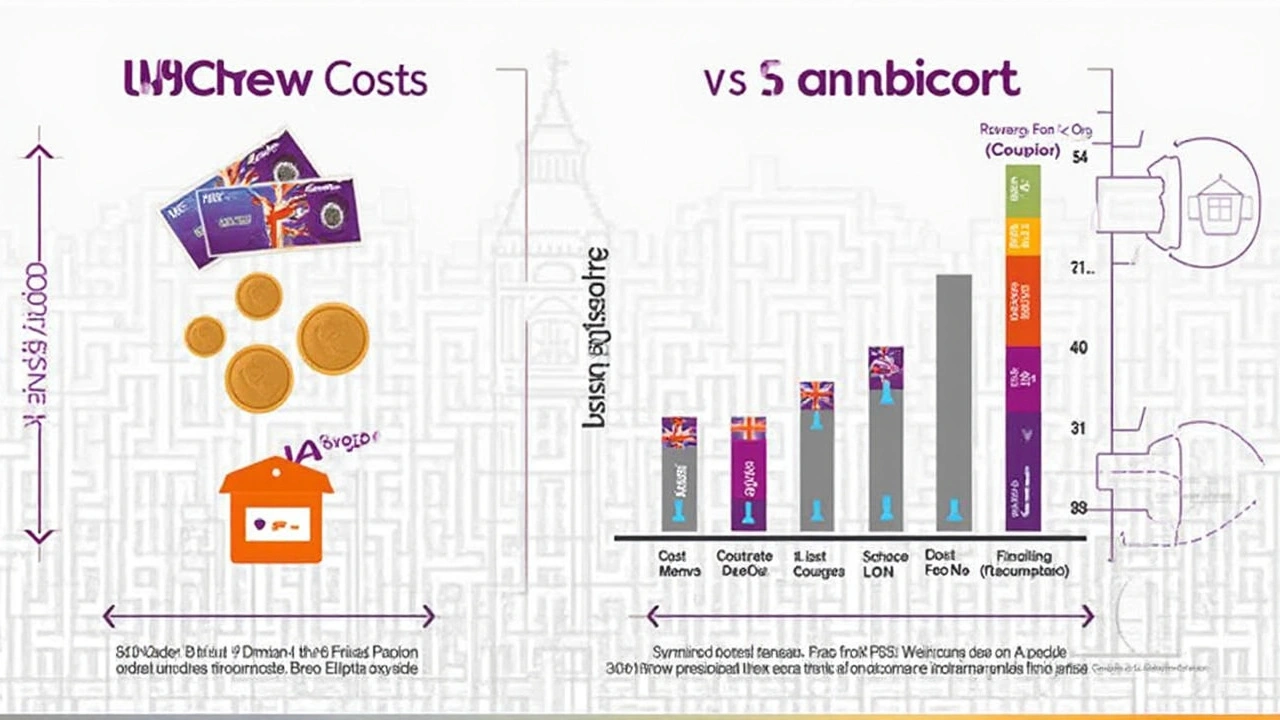
How Much Will Breo Ellipta and Symbicort Actually Cost You in 2025?
Staring at the pharmacy bill for your next inhaler refill can leave you a little breathless—and not in a good way. If you've ever wondered why that plastic tube in your hand costs more than a family pizza night, you're not alone. Breo Ellipta and Symbicort lead the pack for asthma and COPD inhalers, but their price tags have made plenty of folks nervous to tap their insurance card. So, how much can you expect to shell out in 2025?
First up, the sticker price. A single Breo Ellipta inhaler (30 doses) sits around $410 to $470 at retail. Symbicort, with 120 metered doses per inhaler (usually a month's supply at two puffs per day), varies from $350 to over $400 without insurance. And that’s just for one month. Let me spell it out clear: if your insurance isn’t chipping in, that’s up to $5,600 a year. Not a typo. That’s more than a used car or a vacation to Italy—though frankly, both sound more fun than coughing and wheezing all day.
Insurance can take most of the bite out of the price, but out-of-pocket amounts can still swing wildly. High-deductible plans or Medicare with tiers can mean $30 to $80 per month, or sometimes much higher until your deductible’s met. Some people luck out and pay $10 or less after meeting annual out-of-pocket maxes, though that’s the exception. If you’ve got a Health Savings Account (HSA), it’ll cover these costs—but that’s your own cash, just set aside tax-free.
Here’s a side-by-side since numbers help me (and Etta, my daughter, who likes laying out her snack comparisons in meticulous columns). Let’s run through the monthly and annual math for 2025:
| Medication | Monthly Retail Cost | Annual Retail Cost |
|---|---|---|
| Breo Ellipta | $410–$470 | $4,920–$5,640 |
| Symbicort | $350–$400 | $4,200–$4,800 |
If you’re seeing numbers higher (or lower) at your pharmacy, it's probably a mix of insurance deals and local markup. Some chains quietly add $20–$30 per inhaler, so shopping around—yes, for medicine, not just bananas—can pay off.
Next up: savings programs. Both Breo Ellipta and Symbicort offer coupons from the manufacturer. Breo’s “Savings Card” can knock the price to $0 for the first 12 fills, up to $15 a month (typically only for commercially insured folks, not federal healthcare). Symbicort’s coupon covers up to $60 off 12 refills a year, but the same insurance rules apply. No commercial insurance? Those offers probably won’t work for you. Think of these coupons like an exclusive club for the “just-insured” crowd.
Then there’s the hunt for generic and alternatives. Breo Ellipta doesn’t have a generic yet—GlaxoSmithKline is still protecting the recipe. Symbicort finally saw generic budesonide/formoterol hit the shelves in mid-2022, and it can be 20%–30% cheaper, though prices remain high due to patent tweaks. You’ll want to double-check with pharmacies since not every location carries the generic, and inventory flips fast. Want the real breakdown and some practical shopping tips? Instead of pain-stakingly searching everywhere, check this well-researched guide: Breo Ellipta vs Symbicort cost, which gathers up-to-date costs and alternatives in one spot.
Outside manufacturers’ deals, some pharmacies (especially big boxes and online) offer loyalty cards or generic discounts, but don’t expect half-off. Price comparison tools like GoodRx or WellRx sometimes save $25 to $100, depending on where you live. Jasper, our Scottish Fold cat, basically has more prescription options than budget-conscious humans, which is just wild.
Here’s the takeaway: factor in not just monthly cost, but whether coupons, generics, or smart shopping can scuff a few bucks off the total. If you’re managing asthma or COPD for years, those little savings add up. I always remind Harland, my son, that every quarter saved on groceries means a few more car tracks for his train set—same logic applies with prescription savings.

Chasing Breath: Effectiveness of Breo Ellipta vs Symbicort in Real Life
You probably don’t care about molecule structures and patent fights—you care about breathing, especially when pollen hits or winter air turns sharp. So, does Breo Ellipta or Symbicort actually keep you out of the wheezy zone? Let’s break it down by how each works, and what people really experience beyond the clinical studies.
Breo Ellipta is a once-a-day inhaler combining fluticasone furoate (a pretty strong corticosteroid) with vilanterol, a long-acting beta agonist. The biggest selling point is the once-daily dose—set it, forget it, and go about your day. Symbicort mixes budesonide (another corticosteroid) with formoterol—a different long-acting bronchodilator. Symbicort is typically twice daily (morning and night) with two puffs each time.
Clinical trials show both make a big difference for moderate to severe asthma and many adults with COPD. For asthma, big trials have found Breo Ellipta to reduce exacerbations (those hospital-worthy attacks) by up to 30% compared to inhaled steroids alone. Symbicort isn’t far behind, generally cutting exacerbations by about 25-28%. For COPD, real-world data gets murkier since patient routines vary and a lot of folks end up on triple therapy anyway (adding a LAMA like tiotropium).
Real users report that the simplicity of Breo Ellipta’s once-daily use is a gamechanger, especially for busy parents—believe me, mornings are a circus with my two, so forgetting a second dose is a familiar story. Less frequent dosing = fewer missed doses. But, Symbicort’s advantage is flexibility and faster symptom relief. Its formoterol component kicks in within 1-3 minutes, while Breo’s vilanterol takes roughly 15 minutes to peak. If you tend to get hit by sudden attacks, Symbicort can feel a bit more responsive.
Side effects? Both carry the usual suspects: throat irritation, hoarseness, maybe a bit of jitteriness or yeast infections (especially if you don’t rinse your mouth). Rarely, either can trigger tremors or headaches. In a few head-to-head studies, rates of the most annoying side effects (hoarse voice, oral thrush) were nearly identical between the two. But people over 65, or those with persistent voice changes, might do better with Symbicort’s slightly shorter steroid duration.
Adherence rates tell a story, too. In a large UK survey, patients on Breo Ellipta (once-daily) were about 19% more likely to stick to their prescription than those on twice-daily inhalers. Skipped doses increase the chance of sudden attacks—so fewer missed doses means better protection. If you’ve got little kids or a shifting schedule, Breo’s once-daily routine can be a lifesaver for your routine, not just your lungs.
But everyone’s different. Some people find Breo doesn’t quite cover those late-evening symptoms, while Symbicort users are more likely to say it calms bouts of breathlessness faster. Your doctor might tweak the dose back or forward depending on your pattern—don’t be surprised if your asthma plan evolves over time.
Both inhalers work best when paired with smart lifestyle tweaks. That means an air purifier if you’re city-bound, dusting more often than your cat cares for, or checking pollen in the spring. It sounds simple, but using a spacer and rinsing your mouth after inhaling really does keep the nastier side effects at bay. Etta loves making a mouth rinse "potion" out of mint water—it turns a boring chore into a magic trick, at least for her.
Here’s a pro tip for parents, since I’ve been there: Symbicort has approval for kids 6 and up in many countries, while Breo Ellipta is generally aimed at adults (over 18). Ask your doc before swapping, especially for the younger set, since guidelines and insurance rules differ.
Keep in mind, you might find one plan works for a while, then life throws curveballs (hello, new allergies, or that surprise respiratory infection from daycare season). Some people switch between these inhalers several times before settling. Just be vocal about what’s working or not—no need to tough it out in silence.
When it comes to raw effectiveness, the score is close. One dose a day or two a day, both majorly improve quality of life if used as prescribed. The tiebreaker often ends up being how well the routine fits into your life and which inhaler your insurance (or wallet) prefers.

Smart Ways to Save: Coupon Programs, Generics, and Financial Tips
High prices suck, plain and simple. It blows my mind that the cost of keeping your lungs happy comes with the sticker shock of a designer handbag. But with a bit of hustle, there are ways to cut the bill that most folks miss.
The top savings path? Leverage those manufacturer coupon cards—but check the fine print. If you’re on Medicaid, Medicare, or VA insurance, you’re usually out of luck; coupons are built for the privately insured only. For Breo Ellipta, the savings card shaves down the copay to as little as $0 for 12 months, but only if your insurance is playing ball. Get the card online, hand it to the pharmacist, and double-check your new total before you leave. Symbicort’s program isn’t quite as generous, but $60 off per fill adds up over the year.
If you land in the insurance doughnut hole, or just straight-up pay cash, use pharmacy discount cards like GoodRx, SingleCare, or WellRx. Plug your zip code into the site, and see if a different chain or mom-and-pop pharmacy beats your regular spot. Sometimes, the price can swing by over a hundred bucks between locations, no joke. Enter your meds on each site, check for hidden fees, and treat your prescription like back-to-school shopping—comparison rules the day.
I can’t count how many times Etta’s playdates got swapped from the park to the pharmacy checkout line because I’d forgotten to run the price check first (parent life, I guess). Now, I set reminders: before every refill, do a five-minute online search. Also, don’t skip asking about the generic if you’re on Symbicort. Some pharmacists don’t volunteer it unless you explicitly say you’re looking for the generic (budenoside/formoterol). Even if the cost savings aren’t massive now, insurance might prefer it and bring your copay down with no extra hassle.
Reach out directly to your insurance provider each year to check if either inhaler lands on a preferred drug list (formulary). These lists change all the time, and you could see a nearly 50% drop in copay if one brand suddenly gets favored over the other. Open enrollment is the moment for this: review which inhalers are “preferred” and tell your prescriber, even if it means swapping brands. No loyalty to inhaler labels—your wallet will thank you.
Patient assistance programs (PAPs) exist for those in a rough spot, especially if you’re out of work or uninsured. Both GSK (Breo) and AstraZeneca (Symbicort) have forms you can fill out if you meet income limits; these usually need a doctor’s sign-off and proof of financial need but can sometimes get you free inhalers for a year or more. Pharmacies rarely bring this up, so it’s up to you to go hunting online. A little extra effort can mean hundreds saved.
If you need the inhaler for your kid, check if a state-level kids’ program or nonprofit can step in for co-pay relief. Many of these are tied to state health programs or asthma coalitions. Childhood asthma sucks, plain and simple, and the last thing families need is extra bills on top of all that. Pro tip: Keep contact information (digital and paper) for each program, since renewal paperwork can sneak up on you every 6–12 months.
Looking for additional alternatives and nuanced cost breakdowns? There’s a solid resource out there: Breo Ellipta vs Symbicort cost—worth bookmarking, especially if your insurance ever changes mid-year.
Finally, if you’re juggling multiple meds, use a prescription savings app to track and alert you to price drops or coupons you didn’t know existed. A friend of mine literally saved $250 just by switching to a pharmacy chain she’d never tried. It’s wild how much the same drug can cost fifty bucks more just on the other side of town or online.
Your routine, your budget, and your health are all tied together. The truth: there’s no perfect winner in the battle of Breo Ellipta vs Symbicort. Your doctor, your insurance, and sometimes just life circumstances will steer which inhaler ends up on your bathroom shelf. Both are proven, both have quirks, and both involve some strategic thinking if you want to avoid the punch to your wallet.

 Health and Wellness
Health and Wellness
Nathan Hamer
May 4, 2025 AT 17:15Life is a series of breaths, and each inhaler is a promise to the future! 🌬️✨ When the price tag of Breo Ellipta looms like a mountain, we are reminded that health often competes with commerce! The staggering $410‑$470 monthly cost forces us to confront the absurdity of putting a price on every sigh and gasp. Yet, hope flickers in the form of coupons, savings cards, and the relentless pursuit of generics-each a tiny candle against the darkness of debt. Imagine a world where the only thing you count is the number of breaths you take, not the dollars you spend! 😅💸 The once‑daily convenience of Breo is a hymn to simplicity, a rhythmic reminder that consistency can win the battle against forgetfulness. Meanwhile, Symbicort’s rapid‑acting formoterol whispers a different promise: relief at the speed of a startled heart. Both drugs, like two philosophical schools, argue over the primacy of timing versus adherence. The data shows a 30% reduction in exacerbations for Breo, a modest yet meaningful victory. Symbicort’s 25‑28% cut is no underdog either; it simply wears a different mask. In the grand theater of asthma and COPD, we are all actors, improvising on a stage made of insurance formularies and pharmacy price ladders. The drama intensifies when high‑deductible plans yank the rug from under your budget, turning a $10 copay into a $80 nightmare. Yet, clever shoppers can turn the tide by rotating pharmacies, hunting GoodRx discounts, and leveraging HSA funds-each tactic a plot twist in our ongoing saga. Remember, the mouth rinse ritual after each puff isn’t just hygiene; it’s a ceremony that defies the tyranny of side effects! 🦠💧 And if you ever feel the weight of the system pressing down, recall that collective action-talking to doctors, demanding formulary changes, supporting patient assistance programs-can reshape the script. So breathe deep, dear reader, and let the inhaler be a tool, not a tyrant, in your quest for freedom! 🙏🚀
Tom Smith
May 4, 2025 AT 17:32Ah, the glorious world of manufacturer coupons-where the fine print reads like a cryptic novel and the eligibility criteria are about as inclusive as a secret society. If you happen to be on Medicaid, Medicare, or any government‑backed plan, enjoy watching those “$0 for 12 fills” promises evaporate faster than morning fog. Meanwhile, the privately insured get to waltz through checkout with a sparkling savings card that looks more like a loyalty badge than a medical necessity. One might suggest that the real miracle is not the discount itself, but the fact that the system allows such a disparity without a single apology. In any case, a quick scroll through GoodRx or SingleCare can shave off a respectable chunk-if you’re willing to exchange a few minutes of your precious time for a few dollars saved. Isn’t that the very definition of efficiency?
Kyah Chan
May 4, 2025 AT 17:49From an analytical standpoint, the comparative cost analysis presented fails to incorporate the stochastic variability inherent in regional pricing mechanisms. The omission of a confidence interval for the stated retail ranges compromises the statistical robustness of the argument. Moreover, the reliance on anecdotal pricing observations without a methodological framework introduces a bias that undermines the credibility of the conclusions drawn.
Ira Andani Agustianingrum
May 4, 2025 AT 18:05Hey there, navigating these inhaler costs can feel like climbing a steep hill, but you’ve already taken the first step by gathering the info-great job! 🎉 Remember, every little savings counts: use discount apps, ask your pharmacist about generic budesonide/formoterol, and keep an eye on your insurance formulary during open enrollment. If you notice a price drop at a nearby pharmacy, don’t hesitate to switch; the hassle is worth the extra bucks in the long run. And most importantly, stay consistent with your dosing schedule-whether it’s once‑daily Breo or twice‑daily Symbicort-because adherence is the true game‑changer for your health. You’ve got this, keep breathing easy! 💪
James Higdon
May 4, 2025 AT 18:22It is a moral imperative that we, as a society, ensure access to essential medications without imposing prohibitive financial burdens. When a life‑saving inhaler carries a price tag comparable to a modest automobile, we must question the ethical foundations of such pricing structures. Healthcare should not be a privilege reserved for the affluent, but a universal right guaranteed to all citizens. Policy makers bear the responsibility to regulate drug costs, promote transparency, and support patient assistance programs that alleviate undue hardship. Let us advocate for reforms that align profit motives with the well‑being of those who depend on these treatments.
Wanda Smith
May 4, 2025 AT 18:39Did you ever notice how the “free coupon” program never works when you actually need it?